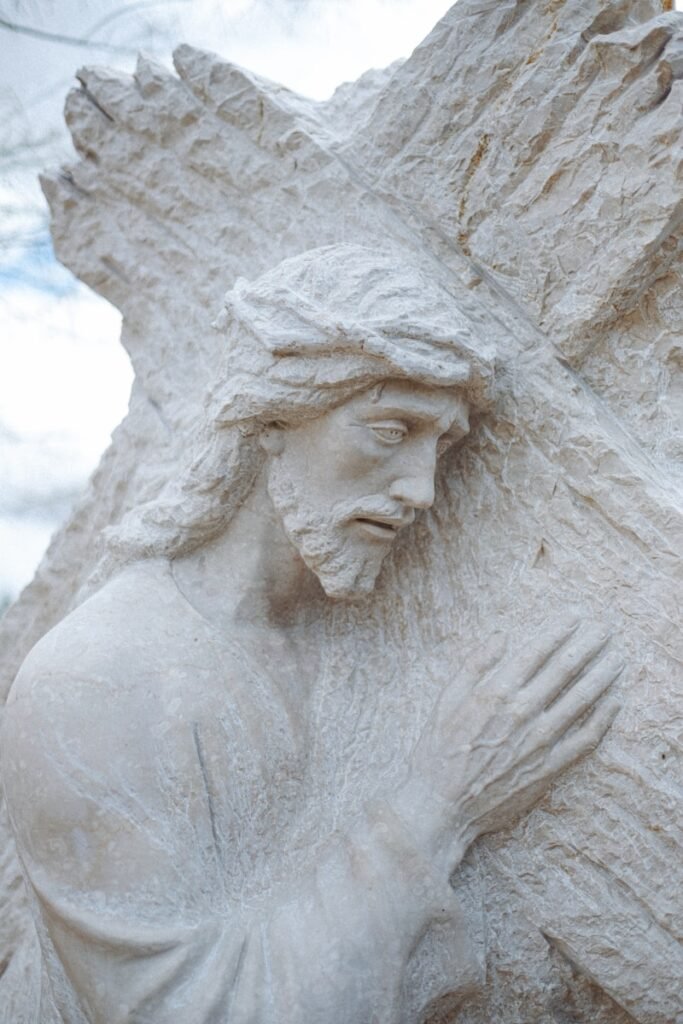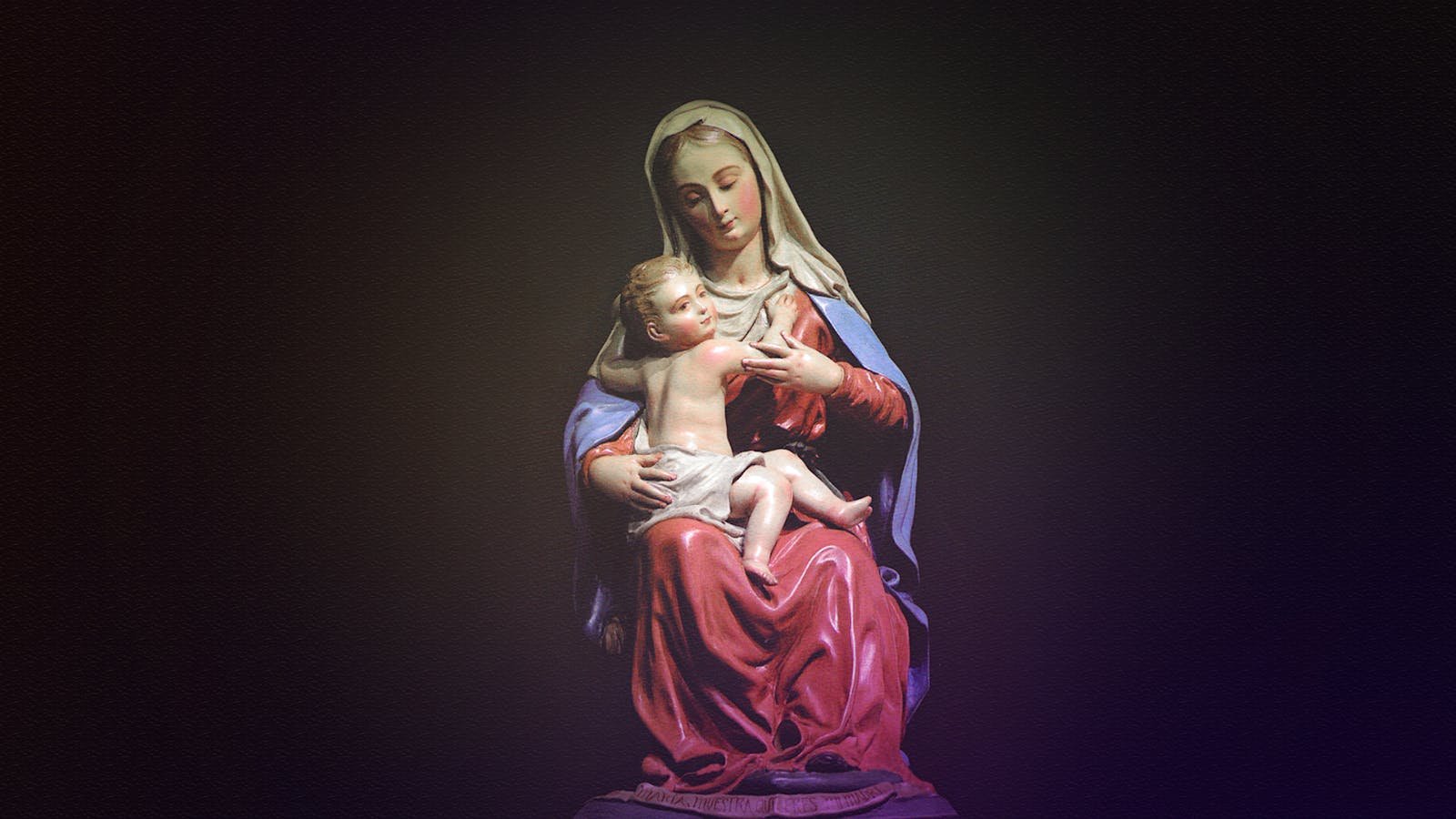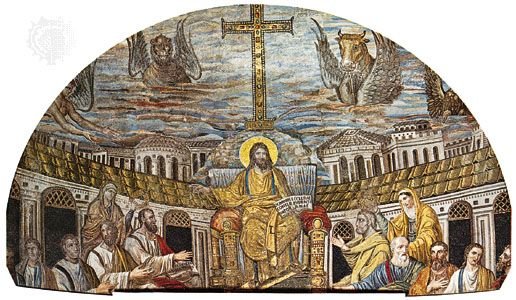As we journey through life, there are moments that stay with us forever. Moments that pierce our hearts and etch their memories into our souls. One such moment for me was the realization of the depth of a mother’s love and sacrifice. It was during a Sunday sermon when the story of Mary, the mother of Jesus, unfolded before me. It was a story of strength, faith, and unimaginable pain. It was a story that made me ponder a question that has lingered for centuries – Did Mary know Jesus would die?
Table of Contents
The Role of Mary in Jesus’ Life
Before delving into the question of whether Mary knew about Jesus’ death, it is essential to establish the significant role she played in his life. According to biblical accounts and traditions, Mary was not just any mother; she was the mother of Jesus, the central figure of Christianity.
Mary’s connection to Jesus goes beyond mere biological ties. She is widely regarded as a model of faith and devotion, chosen by God to bear and raise the Messiah. Her role as the mother of Jesus endowed her with a unique perspective and intimate understanding of his life and ministry.
In the Gospels, we see Mary’s presence and participation throughout crucial moments of Jesus’ earthly journey. From the announcement of his miraculous birth to her attendance at his first miracle in Cana, Mary consistently demonstrated her support and belief in her son’s mission.
| Key Events | Mary’s Involvement |
|---|---|
| Annunciation | Receives the angel Gabriel’s message about the coming birth of Jesus |
| Nativity | Gives birth to Jesus in Bethlehem |
| Presentation in the Temple | Presented Jesus to the Lord in accordance with Jewish customs |
| Flight to Egypt | Flees to Egypt to protect Jesus from King Herod’s threat |
| Return to Nazareth | Settles with Jesus and Joseph in Nazareth |
| Wedding at Cana | Asks Jesus to perform his first public miracle, transforming water into wine |
Through her unwavering commitment, Mary displayed a deep understanding of her son’s divine purpose. While the extent of her knowledge regarding Jesus’ death remains a subject of debate, her presence at significant events throughout his life suggests a profound and intuitive comprehension of his destiny.
“Behold, I am the handmaid of the Lord; let it be to me according to your word.” – Mary’s response to the angel Gabriel, Luke 1:38
Ultimately, Mary’s role as Jesus’ mother extends far beyond mere biological connection. Her steadfast faith, unwavering love, and unique insight into his life solidify her as a crucial figure in biblical narratives and Christian faith.
Prophecies of Jesus’ Death

In the Old Testament, numerous prophecies foreshadowed the crucifixion and sacrifice of Jesus. These prophecies were known and understood by those in Jesus’ immediate circle, including Mary, his mother. They hold significant implications for Mary’s understanding of Jesus’ fate and the profound role she played in God’s plan of salvation.
The crucifixion prophecy found in Psalm 22 paints a vivid picture of the suffering and agony Jesus would endure on the cross. The Psalmist’s vivid description of pierced hands and feet, the mocking crowd, and the utter forsakenness echo the events of Jesus’ crucifixion with striking similarity.
“…they have pierced my hands and feet… they divide my garments among them, and for my clothing they cast lots.” – Psalm 22:16-18
Isaiah’s prophecy in chapter 53 further illuminates the depth of Jesus’ sacrificial death. The passage describes the Messiah as a “man of sorrows” acquainted with grief, wounded for our transgressions, and oppressed and afflicted. This prophecy speaks to the vicarious nature of Jesus‘ sacrifice and the redemption it offers to humanity.
“Surely he has borne our griefs and carried our sorrows… he was pierced for our transgressions; he was crushed for our iniquities… …by his wounds we are healed.” – Isaiah 53:4-5
Among the prophecies, Zechariah’s words in chapter 12, verse 10 stand out with particular relevance to Mary’s understanding. The prophet proclaimed that the people would look on “the one they have pierced” and mourn for him as one mourns for an only son. This foreshadowing of the piercing and inevitable mourning resonates deeply with the anguish Mary experienced as she witnessed her own son’s crucifixion.
“And I will pour out on the house of David and the inhabitants of Jerusalem a spirit of grace and pleas for mercy, so that, when they look on me, on him whom they have pierced, they shall mourn for him, as one mourns for an only child, and weep bitterly over him, as one weeps over a firstborn.” – Zechariah 12:10
These prophecies, along with others found throughout the Old Testament, provide a glimpse into the divine plan of salvation and the role Mary played in its fulfillment. Though the exact extent of her understanding remains a mystery, it is evident that Mary’s knowledge of these prophecies would have deepened her comprehension of Jesus’ sacrificial mission.
Mary’s Encounter with Simeon
In the Gospel of Luke, we find a significant moment in Mary’s journey of understanding her son’s mission and ultimate sacrifice. This encounter with Simeon sheds light on Mary’s knowledge and perception of Jesus’ destiny.
“Simeon took him in his arms and praised God, saying, ‘Sovereign Lord, as you have promised, you may now dismiss your servant in peace. For my eyes have seen your salvation, which you have prepared in the sight of all nations: a light for revelation to the Gentiles, and the glory of your people Israel.'”
Simeon’s prophetic words acknowledge Jesus as the salvation of all nations and the fulfillment of God’s promise. This revelation must have deepened Mary’s understanding of her son’s extraordinary purpose and the weight of the sacrifice he was destined to make.
The encounter with Simeon also reinforces biblical knowledge regarding the role of Jesus in the redemption of humanity, aligning with the prophecies and the greater purpose revealed in scripture.
As Mary witnessed these words of affirmation and devotion, it undoubtedly played a pivotal role in shaping her understanding and conviction in Jesus’ divine mission.
The Role of Simeon
Simeon, who was righteous and devout, had been promised by the Holy Spirit that he would not die before seeing the Lord’s Messiah. His recognition of Jesus as the Savior reflects a heightened spiritual discernment and bears witness to the significance of the moment.
This encounter highlights the interconnectedness of Mary’s understanding and biblical prophecies, affirming her crucial role in the unfolding of God’s plan through Jesus.
Implications for Mary’s Understanding
The encounter with Simeon likely deepened Mary’s awareness of Jesus’ fate and purpose. It provided an explicit affirmation of his divine mission and the impact he would have on the world.
Mary’s encounter with Simeon serves as a crucial milestone in her journey of comprehending the sacrifice her son was destined to make, furthering her understanding of the profound significance of Jesus’ life and death.
Mary’s Presence at Crucifixion
Despite the sorrow and anguish she must have experienced, Mary, the mother of Jesus, remained steadfast and was present at the crucifixion of her beloved son.
Her presence at this pivotal moment holds immense significance, shedding light on her deep understanding of Jesus’ impending sacrifice.
“Now there stood by the cross of Jesus his mother, and his mother’s sister, Mary the wife of Cleophas, and Mary Magdalene. When Jesus therefore saw his mother, and the disciple standing by, whom he loved, he saith unto his mother, Woman, behold thy son! Then saith he to the disciple, Behold thy mother! And from that hour that disciple took her unto his own home.” – John 19:25-27
Mary’s presence at the crucifixion is a testament to her unwavering faith and her complete acceptance of Jesus’ mission. It demonstrates her profound understanding of the sacrifice he was making for humanity.
As a mother, witnessing the excruciating death of her son, Mary’s presence speaks to her immense courage and love. Despite the heart-wrenching agony, she stood by Jesus, offering her support and experiencing the depth of his sacrifice firsthand.
| Significance of Mary’s Presence at Crucifixion | Implications for Mary’s Understanding |
|---|---|
| Mary’s unwavering faith | Demonstrates her trust in God’s plan for Jesus’ sacrifice |
| Symbolizes Mary’s motherly love | Reflects her willingness to witness and share in Jesus’ suffering |
| Offers support and comfort to Jesus | Highlights her understanding of the urgency and significance of his mission |
| Witnesses the fulfillment of prophecies | Affirms her knowledge of Jesus’ destiny as part of God’s plan |
Through her presence at the crucifixion, Mary showcases her unwavering devotion and deep understanding of Jesus’ sacrifice. Her role as a witness to his crucifixion underscores the profound bond between mother and son, and the profound faith that guided both of their lives.
Post-Crucifixion Revelation
Following Jesus’ death and resurrection, there were several recorded interactions between him and his disciples. These encounters hold significant value in shedding light on Mary’s understanding of Jesus’ death and its implications. Let us explore these post-crucifixion revelations and their impact on Mary’s perception.
Recorded Interactions with Mary
One of the most notable post-resurrection encounters involving Mary is recorded in the Gospel of John. It is during this encounter that Mary initially mistakes Jesus for the gardener, only realizing his identity when he speaks her name with familiarity:
“Mary!”
Jesus said.
Her immediate recognition of Jesus suggests that Mary’s understanding of his death was deepened or clarified through this encounter. The experience of seeing the risen Christ before her eyes solidified her conviction in his divinity and the fulfillment of his purpose.
Impact on Mary’s Understanding
These post-crucifixion encounters would have undoubtedly had a profound impact on Mary’s understanding of Jesus’ death. Witnessing Jesus’ resurrection firsthand would have reinforced her belief in his messianic mission and his ultimate triumph over death. It would have brought a sense of comfort and hope, assuring her that his sacrifice was not in vain.
Key Post-Crucifixion Revelations
| Date | Event | Scripture Reference |
|---|---|---|
| After Jesus’ resurrection | Encounter between Jesus and Mary | Gospel of John 20:11-18 |
| Post-resurrection period | Various appearances of Jesus to his disciples | Multiple accounts in the Gospels |
These post-crucifixion revelations would have provided Mary with a deeper understanding of Jesus’ sacrificial journey and its profound significance for humanity. While specific details of these interactions may vary across biblical accounts, their collective impact on Mary’s understanding remains indisputable.
Mary’s Impact on Christian Faith
Mary, the mother of Jesus, holds a prominent place in Christian faith and devotion. Her understanding of Jesus’ death and her unique role as his mother have had a profound influence on the early Christian community and its subsequent theological development.
From the biblical accounts, we can infer that Mary possessed a deep spiritual insight into her son’s mission and sacrifice. Her unwavering faith and willingness to surrender to God’s plan played a crucial role in shaping the narrative of Jesus’ life and death.
As a central figure in the Christian story, Mary’s example of devotion and obedience has inspired countless believers throughout history. Her willingness to say “yes” to God’s call, even in the face of uncertainty and suffering, serves as a model of faith for Christians striving to follow in her footsteps.
Furthermore, Mary’s understanding of Jesus’ death and her role in it has been a source of comfort and inspiration for those facing their own trials and tribulations. Her presence at the crucifixion and her unwavering love for her son exemplify the sacrificial love and compassion that Christ calls his followers to emulate.
“She stood by the cross of Jesus where his mother had been, and the disciple whom he loved said to his mother, ‘Woman, behold, your son.’ Then he said to the disciple, ‘Behold, your mother.’ And from that hour the disciple took her into his home.” – John 19:25-27
The significance of Mary’s understanding and her profound impact on Christian faith cannot be overstated. Through her example, believers have found solace, encouragement, and a deeper appreciation for the redemptive power of Christ’s sacrifice.
Mary’s Influence on Christian Theology
| Aspect | Explanation |
|---|---|
| Marian Devotion | The veneration of Mary as the Mother of God and the intercessor between humanity and Christ. |
| Immaculate Conception | The belief that Mary was conceived without original sin, reflecting her purity and unique role in salvation history. |
| Bodily Assumption | The belief that Mary was assumed into heaven, body and soul, at the end of her earthly life, affirming her special place in God’s plan. |
| Mary as Theotokos | The recognition of Mary as the Mother of God, emphasizing the union of divinity and humanity in the person of Jesus Christ. |
In summary, Mary’s understanding of Jesus’ death and her role as his mother has deeply influenced Christian faith and devotion. Her example of faith, obedience, and sacrificial love continues to inspire believers worldwide and serves as a testament to the enduring impact of her profound understanding and biblical knowledge.
The Mystery of Mary’s Knowledge
Throughout this article, we have explored the question of whether Mary, the mother of Jesus, had knowledge of her son’s impending death. While the exact extent of Mary’s understanding remains a mystery, biblical insights and historical perspectives shed light on this intriguing topic.
From biblical accounts, we gather that Mary played a significant role in Jesus’ life. She witnessed his miraculous birth, nurtured him as a mother, and accompanied him in his ministry. Mary’s intimate connection with Jesus suggests that she possessed a profound understanding of his mission and purpose.
Prophecies in the Old Testament foretold Jesus’ crucifixion and sacrifice. As part of Jesus’ immediate circle, including Mary, it is likely that she would have been aware of these prophecies. This knowledge may have influenced her understanding of Jesus’ fate and contributed to her acceptance of his sacrifice.
While the specific details of Mary’s knowledge are not explicitly detailed in the scriptures, her presence at the crucifixion speaks volumes. Despite the immense pain and sorrow she must have felt, Mary stood by her son, witnessing the culmination of his mission. This demonstrates her unwavering support and suggests a deep understanding of Jesus’ ultimate sacrifice.
In conclusion, the mystery surrounding Mary’s knowledge of Jesus’ impending death invites speculation and reflection. While we cannot definitively answer the question of whether Mary knew Jesus would die, her role as Jesus’ mother, the prophecies foretelling his crucifixion, and her presence at the crucifixion itself indicate a profound understanding and acceptance of God’s divine plan.
FAQ
Did Mary know that Jesus would die?
The extent of Mary’s knowledge regarding Jesus’ death is not explicitly stated in the Bible. While there are no specific passages that detail her awareness of the events to come, it can be inferred that Mary had some understanding of Jesus’ sacrifice based on her encounters and experiences throughout his life.
What is the role of Mary in Jesus’ life?
Mary played a crucial role in Jesus’ life as his mother. She was chosen to give birth to and raise Jesus, providing an important foundation for his mission and ministry. Mary’s presence throughout Jesus’ life demonstrates the deep connection and bond between mother and son.
Are there any prophecies about Jesus’ death?
Yes, the Old Testament contains various prophecies that foreshadowed Jesus’ crucifixion and sacrifice. These prophecies were known and understood by Jesus’ immediate circle, including Mary. Their fulfillment in Jesus’ life underscores the divine plan and purpose behind his death.
What happened during Mary’s encounter with Simeon?
Mary’s encounter with Simeon is recorded in the Gospel of Luke. Simeon, guided by the Holy Spirit, recognized Jesus as the Messiah and prophesied about his future suffering and Mary’s own involvement. This encounter provided insight into Mary’s understanding of Jesus’ mission and the hardships he would face.
Was Mary present at Jesus’ crucifixion?
Yes, despite the immense sorrow she must have experienced, Mary was present at the crucifixion of Jesus. Her presence at this pivotal moment showcases her unwavering love and support for her son, and suggests that she had an understanding, to some extent, of the significance of his sacrifice.
Are there any recorded interactions between Jesus and Mary after his resurrection?
The Bible does not record any specific interactions between Jesus and Mary after his resurrection. However, there were encounters between Jesus and his disciples, and it is possible that Mary was among those who had such experiences. These encounters likely deepened the disciples’ understanding of Jesus’ death and resurrection.
How did Mary’s understanding of Jesus’ death impact the early Christian community?
Mary’s role as Jesus’ mother and her understanding of his death had a profound impact on the early Christian community. Her unwavering faith and sacrifice served as an example and source of inspiration for believers. Mary’s unique relationship with Jesus continues to hold a significant place in Christian devotion and theology.
What is the mystery surrounding Mary’s knowledge of Jesus’ death?
While the exact extent of Mary’s knowledge regarding Jesus’ death remains unknown, her presence throughout pivotal moments of his life suggests that she had an understanding, to some degree, of the events that would unfold. The mystery surrounding Mary’s knowledge also invites reflection and reverence for her role in the Christian narrative.

Rockin’ the faith, one verse at a time!
Growing up, the Bible’s stories deeply impacted me. Now, with over 15 years of preaching experience, I blend timeless teachings with modern technology, making them relevant for today’s world.
Bible Hub Verse is my platform to share historical insights and thought-provoking articles, exploring both familiar and uncommon Christian topics. My passion is building a welcoming online space for everyone to learn, grow in their faith, and discover the Bible’s enduring message.
Join the journey!
God bless you.






